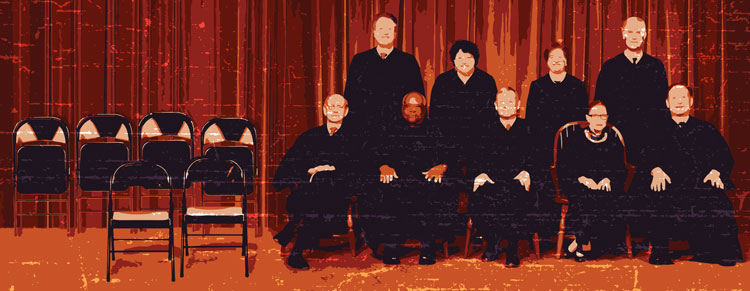Justice by Numbers: Proposals resurface to expand the size of the court

Illustration by Sara Wadford
The U.S. Constitution’s Article III says the judicial power of the nation “shall be vested in one supreme court.” It says nothing about how many justices should serve on the court.
That has led to a range of sizes throughout U.S. history—from five to 10 authorized seats on the court. Now, those advocating an expansion of the high court by two, four, six or some other number of seats are having their moment.
In recent months, a concept that has been on the fringes of political theory has suddenly gained steam, with several progressive organizations calling for an expansion of the court and pushing Democratic presidential candidates to respond to the idea.
The idea is that if the Democrats win the White House and Senate in next year’s election and retain control of the House of Representatives, they could push for the additional seats on the high court. And those seats would presumably be filled with new left-leaning justices who would shift the balance away from the court’s conservative majority.
“We are in a dire democracy emergency in which the Supreme Court has belonged to the Republican Party and the donor class,” says Aaron Belkin, a political science professor at San Francisco State University and the executive director of Pack the Courts, a fledgling organization that calls for adding four seats.
‘A Hostile Supreme Court’
Belkin says two of those seats would “nullify” the fact that President Donald Trump’s first nominee to the court, Justice Neil M. Gorsuch, won confirmation in 2017 only after Senate Republicans refused to advance President Barack Obama’s nomination of Merrick B. Garland for the vacancy created by Justice Antonin Scalia’s death in 2016.
Belkin and some other progressives believe that Trump’s second nominee, Justice Brett M. Kavanaugh, should be effectively canceled out by adding a third and fourth new seat because the president lacks legitimacy or because of Republicans’ hardball tactics to confirm Kavanaugh.
“The court is a partisan institution,” Belkin says. “Nothing is going to change that.”
Mark Tushnet, a professor at Harvard Law School who leads the advisory board of Pack the Courts, says that Democrats need to realize that if they are to achieve their policy goals on issues such as the environment, immigration and health care, the increasingly conservative-dominated federal courts, including the Supreme Court, likely stand in the way.
“You have to figure out some way to deal with a hostile Supreme Court,” Tushnet says.
Other progressive groups that have been pushing to expand the court, among other radical ideas, include Demand Justice and Indivisible.
The groups’ efforts began to show some traction in March. First, former U.S. Attorney General Eric H. Holder Jr., who served under Obama, told an audience at Yale Law School that expansion of the court should be given serious consideration.
Soon after, Democratic presidential candidates began to offer thoughts on the idea.
Sens. Kirsten Gillibrand of New York, Kamala Harris of California and Elizabeth Warren of Massachusetts have said they would not rule out the idea, while former U.S. Rep. Beto O’Rourke of Texas and Pete Buttigieg, the mayor of South Bend, Indiana, have embraced the concept of expanding the court to 15 members, with five nominated by a Republican president, five by a Democrat and five by unanimous consent of the other 10.
Buttigieg told a CNN town hall in March that he is trying to stop the Supreme Court from “sliding toward being viewed as a nakedly political institution. I’m for us contemplating whatever policy options will allow that to be possible.”
Lessons from FDR’s Plan
While legal experts say the idea of involving justices in choosing some of their peers would require a constitutional amendment, merely adding seats to the court could be done by passing a law.
The Judiciary Act of 1789 created a Supreme Court of one chief justice and five associate justices. An 1801 federal law reduced the size of the court to five justices, but the new administration of President Thomas Jefferson did not allow that law to go into effect.
The six-member court grew to seven in 1807, to nine in 1837 and to 10 in 1863. In 1866, Congress passed a law that would have reduced the court by attrition to seven members, though the size fell only to eight members by 1869, when Congress passed a law setting the size at nine, where it has remained since.
President Franklin Delano Roosevelt’s famous “court-packing” plan came after he was re-elected in 1936, and after the Supreme Court had struck down many of his first-term New Deal programs. Roosevelt’s proposal would have added a new justice for every sitting justice older than 70. (Six of the nine were then over 70, and thus the court might have grown to 15.)
Roosevelt’s plan lacked support among many congressional Republicans and Democrats, and even Chief Justice Charles Evans Hughes worked against it behind the scenes. (At the time, the ABA held a referendum on court-packing that members overwhelmingly opposed.)
When the court shifted course in 1937 and began to uphold New Deal measures, any momentum for FDR’s plan eroded further, and the president’s plan died in Congress.
Belkin says historians have misconstrued the lessons of FDR’s court-packing episode.
“I don’t think what FDR did was a failure,” he says. “Even though he didn’t add justices, his plan did ultimately save the New Deal.”
Jeff Shesol, a historian who wrote an authoritative book on FDR’s court-packing plan, says “the sudden vogue for court-packing is that the appeal of the idea is very much the same as it had for Roosevelt. It feels like a quick fix.”
“I understand the argument that Republicans have been smashing norms to such an extent that the court has been debased,” adds Shesol, who was a speechwriter for President Bill Clinton and is the author of the 2010 book Supreme Power: Franklin Roosevelt vs. The Supreme Court. “But it seems to me to be destructive.”
He says that if the Democrats win power in 2020 and increase the size of the court to 11 or 13 members, Republicans would likely vow to add even more justices when they returned to power to counter those additions.
“It’s hard for me to see how the two parties don’t then get into an arms race,” Shesol says. Senate Majority Leader Mitch McConnell of Kentucky was critical of expanding the size of the court, saying on the Senate floor that “the far left has gone scrounging through the ash heap of American history, and they’re bandying about that discredited fantasy from the 1930s.”
In March, President Trump was asked whether he would consider an effort of his own to increase the size of the court. He said no. “The only reason [Democrats are] doing that is they want to try and catch up,” Trump said at a Rose Garden news conference. “So if they can’t catch up through the ballot box by winning an election, they want to try doing it in a different way. … It’ll never happen.”
Risking ‘Diffuse Support’
Neil S. Siegel, a Duke University law professor, says the Republicans’ use of hardball tactics in recent confirmation battles is a factor that wasn’t a factor with FDR’s court-packing plan. But that doesn’t justify the proposals of today, he says.
“Packing the court would substantially increase the public perception that the court is partisan and political in just the way, and to the same extent, that Congress is, and so would risk jettisoning the significant amount of diffuse support that the court retains,” says Siegel, who served as a special counsel to Sen. Christopher A. Coons, a Delaware Democrat and Judiciary Committee member, for the confirmation hearings for Gorsuch and Kavanaugh.
He says the “legitimate” way to pack the court is to do what FDR ultimately had to settle for—winning elections and nominating and confirming justices of the president’s choosing as vacancies arose.
“Indeed, had most liberals been as focused on the court in 2016 as some of them appear to be today, perhaps it is certain conservatives inside and outside Congress who would be talking about court-packing now,” Siegel says.
Tushnet, who has debated the issue with Siegel, says he doesn’t worry that proposals by progressives and Democrats to add to the court will motivate Republicans to retaliate because conservatives are already mobilized around the court.
As to whether any court-packing plan could really happen, Tushnet says, “I think talking about it is a way of expanding the conversation about the role of the Supreme Court as an obstacle to the substantive policies that Democrats want. That in itself is valuable.”



